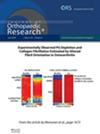Mitochondrial Dysfunction of the Subsynovial Connective Tissue in Patients With Carpal Tunnel Syndrome
Abstract
In idiopathic carpal tunnel syndrome (CTS), fibrosis and thickening of the subsynovial connective tissue (SSCT) increase pressure within the carpal tunnel, resulting in median nerve entrapment. Mitochondrial dysfunction in tissues reportedly leads to senescent cell accumulation and various diseases through reduced adenosine triphosphate (ATP) and excessive reactive oxygen species (ROS) production; however, no reports have linked this to CTS. Therefore, this study aimed to evaluate mitochondrial function in SSCTs of patients with CTS. This study investigated SSCTs obtained during carpal tunnel release surgery in patients with CTS (CTS group) and those obtained during tendon transfer or tendon rupture surgery in patients without CTS (control group) from April 2021 to March 2023 at our hospital. Outcome measures included superoxide dismutase (SOD) activity, gene expression levels, immunofluorescence staining, ATP production assays, and transmission electron microscopy (TEM). p values were calculated using the Mann–Whitney U test. The CTS and control groups included 10 and 5 patients (mean age, 67.8 ± 9.57 and 65.4 ± 9.75 years), respectively. The CTS group exhibited decreased SOD activity (p = 0.026), increased gene expression of mitochondrial biosynthetic factors, and decreased mitochondrial ATP production (p = 0.027). The CTS group showed increased mitochondrial ROS production (p = 0.038) on immunofluorescence and larger mitochondrial area (p = 0.030) and fewer mitochondrial cristae (p = 0.045) on TEM. Multiple mitochondrial function assays suggested mitochondrial dysfunction of SSCTs in the CTS group.
Statement of Clinical Significance
This research provided important information on the histological changes in the subsynovial connective tissue within the carpal tunnel in carpal tunnel syndrome.


 求助内容:
求助内容: 应助结果提醒方式:
应助结果提醒方式:


